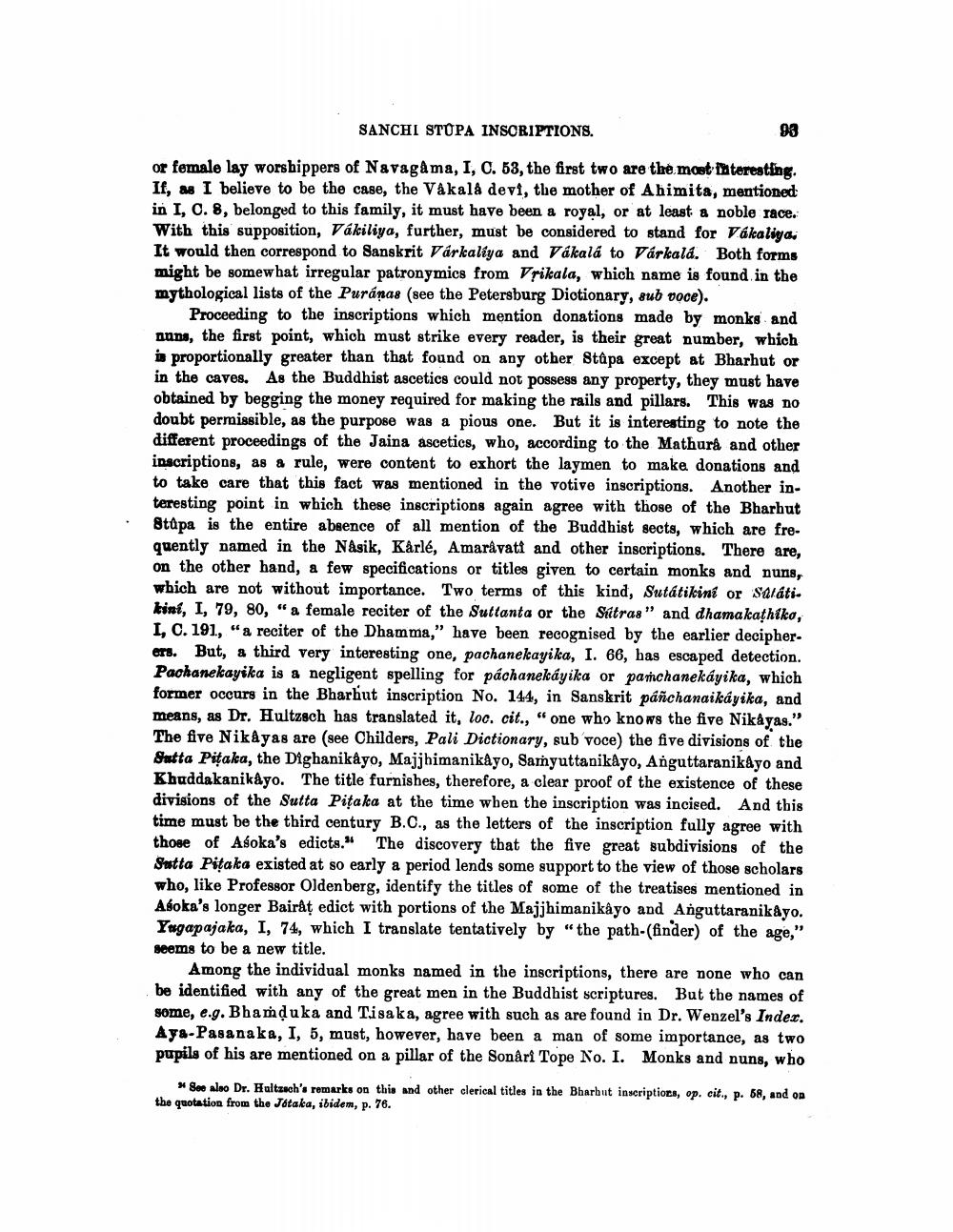________________
SANCHI STUPA INSCRIPTIONS.
98
or female lay worshippers of Navagâma, I, C. 53, the first two are the most interesting. If, as I believe to be the case, the Vakală devi, the mother of Ahimita, mentioned in I, 0.8, belonged to this family, it must have been a royal, or at least a noble race. With this supposition, Vakiliya, further, must be considered to stand for Vákaliya. It would then correspond to Sanskrit Várkaliya and Vakalá to Várkald. Both forms might be somewhat irregular patronymics from Vrikala, which name is found in the mythological lists of the Puranas (see the Petersburg Dictionary, sub doce).
Proceeding to the inscriptions which mention donations made by monks and nans, the first point, which must strike every reader, is their great number, which i proportionally greater than that found on any other Stapa except at Bharhut or in the caves. As the Buddhist ascetics could not possess any property, they must have obtained by begging the money required for making the rails and pillars. This was no doubt permissible, as the purpose was a pious one. But it is interesting to note the different proceedings of the Jaina ascetics, who, according to the Mathura and other inscriptions, as a rule, were content to exhort the laymen to make donations and to take care that this fact was mentioned in the votive inscriptions. Another interesting point in which these inscriptions again agree with those of the Bharhut Stupa is the entire absence of all mention of the Buddhist sects, which are frequently named in the Nasik, Kårlé, Amaravati and other inscriptions. There are, on the other hand, a few specifications or titles given to certain monks and nuns, which are not without importance. Two terms of this kind, Sutátilini or salati. kini, I, 79, 80, "a female reciter of the Suttanta or the stras" and dhamakathiko, I, C. 191, "a reciter of the Dhamma," have been recognised by the earlier decipherers. But, a third very interesting one, pachanekayika, I. 66, has escaped detection. Pachanekayika is a negligent spelling for páchanekāyika or panchanekáyika, which former occurs in the Bharhut inscription No. 144, in Sanskrit páñchanaikáyika, and means, as Dr. Hultzsch has translated it, loc. cit., "one who knows the five Nikåyas." The five Nikayas are (see Childers, Pali Dictionary, sub voce) the five divisions of the Satta Pitaka, the Dighanikåyo, Majjhimanikâyo, Samyuttanikâyo, Anguttaranikdyo and Khaddakanikâyo. The title furnishes, therefore, a clear proof of the existence of these divisions of the Sutta Pitaka at the time wben the inscription was incised. And this time must be the third century B.C., as the letters of the inscription fully agree with those of Asoka's edicts." The discovery that the five great subdivisions of the Sutta Pitaka existed at so early a period lends some support to the view of those scholars who, like Professor Oldenberg, identify the titles of some of the treatises mentioned in Aboka's longer Bairat edict with portions of the Majjhimanikâyo and Anguttaranikâyo. Yugapajaka, I, 74, which I translate tentatively by "the path-(finder) of the age,” seems to be a new title.
Among the individual monks named in the inscriptions, there are none who can be identified with any of the great men in the Buddhist scriptures. But the names of some, e.g. Bhamduka and Tisaka, agree with such as are found in Dr. Wenzel's Index. Aya-Pasanaka, I, 5, must, however, have been a man of some importance, as two pupils of his are mentioned on a pillar of the Sonåri Tope No. I. Monks and nuns, who
* See sloo Dr. Haltzuch's remarks on this and other clerical titles in the Bharbut inscriptions, op. cit., p. 58, and on the quotation from the Jotaka, ibidem, p. 76.




